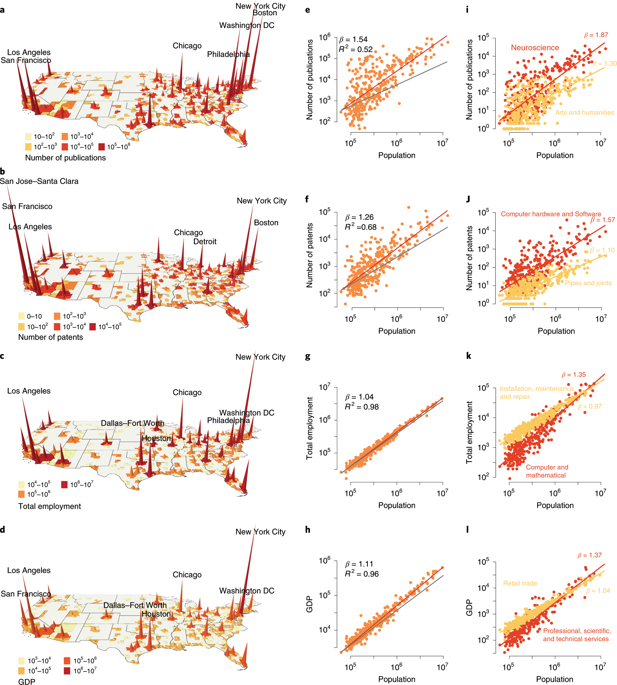Nature Human Behaviour ( IF 21.4 ) Pub Date : 2020-01-13 , DOI: 10.1038/s41562-019-0803-3 Pierre-Alexandre Balland 1, 2 , Cristian Jara-Figueroa 2 , Sergio G Petralia 3 , Mathieu P A Steijn 1, 4 , David L Rigby 5 , César A Hidalgo 2, 6, 7, 8

|
Human activities, such as research, innovation and industry, concentrate disproportionately in large cities. The ten most innovative cities in the United States account for 23% of the national population, but for 48% of its patents and 33% of its gross domestic product. But why has human activity become increasingly concentrated? Here we use data on scientific papers, patents, employment and gross domestic product, for 353 metropolitan areas in the United States, to show that the spatial concentration of productive activities increases with their complexity. Complex economic activities, such as biotechnology, neurobiology and semiconductors, concentrate disproportionately in a few large cities compared to less--complex activities, such as apparel or paper manufacturing. We use multiple proxies to measure the complexity of activities, finding that complexity explains from 40% to 80% of the variance in urban concentration of occupations, industries, scientific fields and technologies. Using historical patent data, we show that the spatial concentration of cutting-edge technologies has increased since 1850, suggesting a reinforcing cycle between the increase in the complexity of activities and urbanization. These findings suggest that the growth of spatial inequality may be connected to the increasing complexity of the economy.
中文翻译:

复杂的经济活动集中在大城市
研究、创新和工业等人类活动不成比例地集中在大城市。美国最具创新力的十大城市占全国人口的 23%,但占其专利的 48%,占其国内生产总值的 33%。但为什么人类活动变得越来越集中?在这里,我们使用美国 353 个大都市地区的科学论文、专利、就业和国内生产总值数据来表明生产活动的空间集中度随着其复杂性的增加而增加。与不太复杂的活动(如服装或造纸)相比,复杂的经济活动,如生物技术、神经生物学和半导体,不成比例地集中在少数大城市。我们使用多个代理来衡量活动的复杂性,发现复杂性解释了城市中职业、工业、科学领域和技术集中度的 40% 到 80% 的差异。我们使用历史专利数据表明,自 1850 年以来,尖端技术的空间集中度有所增加,这表明活动复杂性的增加与城市化之间存在强化循环。这些发现表明,空间不平等的加剧可能与经济复杂性的增加有关。表明活动复杂性的增加与城市化之间存在强化循环。这些发现表明,空间不平等的加剧可能与经济复杂性的增加有关。表明活动复杂性的增加与城市化之间存在强化循环。这些发现表明,空间不平等的加剧可能与经济复杂性的增加有关。











































 京公网安备 11010802027423号
京公网安备 11010802027423号